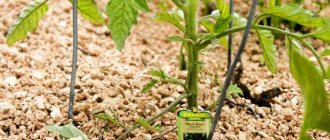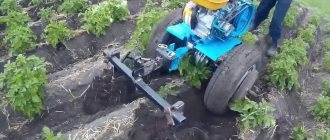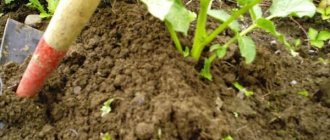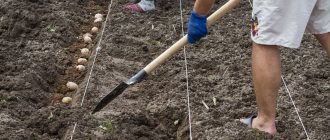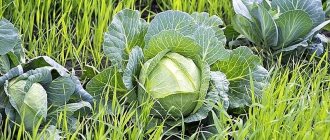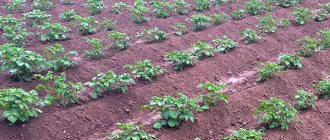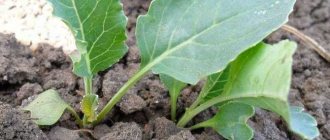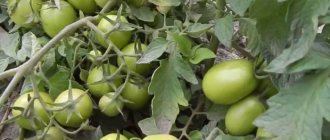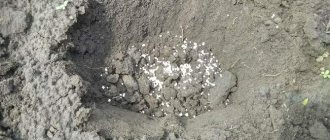To maintain the health of potatoes, protect the plantings from bad weather, and improve the properties of the soil, they resort to mulching, i.e., covering the soil with natural and artificial materials. A plot of potatoes can be mulched before and after planting, always taking into account the characteristics of the crop and agricultural cultivation techniques. If you do everything correctly, mulch for potatoes works wonders and can increase the yield by 1.5-2 times. You can also grow potatoes wisely without weeding and hilling, try different methods.
Purposes of mulching potatoes during and after planting
To use mulch correctly, you need to understand why and when it is used. The obvious advantages of mulching: no need to weed, loosen, or frequently water during dry periods.
Purposes of mulching before planting:
- retain soil heat in the fall, which allows microorganisms and worms to do their work longer;
- in spring it promotes rapid warming of the soil and retains heat;
- in organic mulch decomposed in early autumn, microbiological processes begin that continue until the onset of cold weather, and in the spring, enzymes secreted by microbes begin to work early and decompose organic matter, releasing heat during decay;
- retains moisture (if there is a lot of moisture, then remove the mulch so that the soil dries before planting);
- prevents the growth of weeds that grow before potato seedlings appear;
- prevents the formation of a crust that interferes with the supply of oxygen to the roots - tubers develop better in loose soil;
- eliminates the need for hilling;
- green manure sown in early autumn will become mulch and fertilizer in spring;
- ash scattered on the snow promotes rapid melting and warming of the earth and serves as fertilizer.
Mulching after planting works in a similar way: it prevents the soil from overheating, cooling, or drying out, promotes early emergence, prevents the growth of weeds, protects from unfavorable weather, organic mulch becomes a source of additional nutrition.
Harvesting
As a rule, a shovel is not needed to harvest mulched potatoes. Most of the tubers are located on the surface of loose and soft soil. It is enough to rake away the mulch and pull the bush by the tops. When you pull out a bush, you can see many additional tubers on the lower part of the trunk, which indicates that the yield is twice as high.
Tubers planted under mulch are mostly clean. They just need to dry a little before storing.
What is the best way to mulch potatoes after planting and hilling?
There is a lot of garden work in the spring, so you need to do everything so that you don’t have to redo it and properly prepare the potatoes for planting. Let's consider the option of mulching after planting, when in the fall the potato plot was covered with a thin layer of straw, hay, leaves, etc.
On a note! A thin layer of mulch laid on an area dug up in the fall does not interfere with planting early potatoes. After emergence of seedlings, the thickness of the layer can be increased.
Procedure
- as the snow begins to melt, ash is scattered - when heated, it promotes rapid melting (without ash, the snow will melt 1-1.5 weeks later);
- cover the entire area or part of it with film directly over the mulch - the soil will warm up faster;
- rake up the mulch layer, allow the soil to finally warm up, loosen it, weed it;
- tubers are planted;
- When the seedlings reach a height of 10-15 cm, they hill up and lay mulch.
How to mulch potatoes when planting, so as not to hill up
There is a technology that replaces hilling - the tubers are not buried when planting, but covered with organic bulk mulch, for example, straw, hay.
They begin to prepare the site in the fall:
- remove weeds and plant debris;
- scatter onion peels to protect against the Colorado potato beetle and wireworm, dig up without breaking the lumps;
- scatter ash (200-300 g/1 m²), urea (10-15 g/1 m²) over the surface;
- lay fresh hay (layer 50 cm);
- On top, so that the hay does not swell, manure is laid out (1 kg/1 m²).
Such a shelter improves the composition of the soil, protects against weeds and pests that will not be able to get through the layer of hay for the winter, and those that have overwintered will not get out in the spring. Ash and urea fertilize the soil and are not liked by pests. In the spring, after the snow melts, preparatory work continues.
What to do in spring:
- The hay and manure are compacted with the back of a rake and trampled down with your feet - you should get a layer about 20 cm thick;
- move the mulch to the edges of the area so that it warms up faster;
- when the soil warms up, distribute the hay and manure in an even layer, mark where the rows will be (row spacing is 50-60 cm).
On a note! It is better to use zoned potato varieties as seed material. It is recommended to take small tubers - 3-4 cm in diameter, each with five or more eyes. As with normal planting, they are processed and germinated. With this method of planting in hot weather, the bed is watered once a week (10 l/1 m²).
How to plant:
- make shallow (10-12 cm) holes in soft humus, interval – 40-50 cm;
- put the tuber with the sprouts facing up, sprinkle with ash and crushed eggshells (1 tsp each), a handful of onion peels, and cover with black soil;
- The ridge is covered with dry hay (30 cm), lightly sprinkled with earth on top so as not to swell.
Mulching potatoes with cut grass - pros and cons
One type of organic mulch is grass clippings. It can be used if there is nowhere to get manure or droppings; it quickly starts the processes of intensive plant nutrition. After mowing, bacteria begin to multiply rapidly in the grass, releasing nutrients and carbon dioxide. There is no need to dry it - moisture is necessary for the existence of microorganisms. Lay freshly cut grass between the potato rows and nests.
Along with the general properties of mulch listed above, grass clippings have their own advantages:
- is a pure organic fertilizer that is always on hand;
- It’s not difficult to prepare;
- the loose texture preserves the natural ventilation of the soil, which does not settle and remains loose.
The use of grass clippings has limitations. For example, it cannot be used on heavy clay soil, or laid in too thick a dense layer - the soil stops breathing. It is not recommended to mulch with grass containing seeds and roots - the seeds may germinate and the roots may take root. From “adult” and young grass you can prepare “hot grass”.
Basic information about culture
Potato is an annual herbaceous plant.
A potato bush up to 1 meter high consists of erect ribbed stems covered with intermittently unpaired pinnately dissected leaves. The inflorescence of a potato is a curl consisting of white, pink or purple flowers. The fruit is a multi-seeded green berry, no more than 20 mm in diameter. The growing area of this crop in Russia covers almost its entire territory: the Middle Zone (not only Moscow and the Moscow region, but also all areas of the Non-Black Earth Region), the Urals, Siberia, the Far East, southern regions, the Caucasus.
Potato harvest
Potatoes are grown on soils that have high fertility: optimal soil structure, high levels of nutrients and humus, and a slightly acidic or nearly neutral environment. In the technology of potato cultivation, along with methods of soil cultivation, planting and measures to combat pests and diseases, such an event as mulching occupies an important place. This is what will be discussed in this article.
Other ways to mulch potatoes
Organic and artificial material can be used as mulch for potatoes. His choice is influenced by the composition and quality of the soil, the area of the plot, financial and physical capabilities. It is possible to simultaneously use different types of mulching material, which significantly reduces labor costs.
Sawdust
The use of sawdust for mulching has limitations - fresh sawdust acidifies the soil, so it is better to use old, almost rotten ones. When using them, it is necessary to feed the soil with organic matter and minerals, because sawdust, when decomposed, will not provide sufficient nutrients, but will protect against heat, cold, and moisture evaporation. The layer of sawdust should not exceed 3-5 cm and it must be loosened regularly - compacted sawdust does not allow air to pass through well.
Leaves
Fallen leaves, like hay and straw, are used to mulch potatoes, but they cannot be taken from under bushes or trees affected by any infection - only healthy ones are suitable (to be safe, they can be treated with antifungal agents). The foliage is laid out between rows, nests, and lightly sprinkled with earth on top to prevent it from swelling.
Film
The film does not allow air to pass through, so a greenhouse effect is created under it and tuber germination occurs faster. It is better to use light film material, since under dark film the earth overheats, and high temperatures negatively affect the development of tubers. On large areas, using film is difficult and not profitable, but on small beds its use is completely justified.
How to use:
- dig holes in a pre-dug area, cover it with film, secure it along the edges with pegs and bricks;
- make cross-shaped cuts above the holes;
- plant potatoes;
- As soon as the seedlings grow, remove the shelter and spud the bushes.
Cardboard
Natural mulch can be replaced with cardboard - it is safe and made from degradable materials. Features of application: the soil needs to be well dug up and fertilized. Lay cardboard between the rows and nests, cutting holes for the plant, and lay a layer of straw on top. The stems do not come into contact with the soil, which protects against infection.
Compost
Good compost will become a source of nutrients, and tubers in loose soil will grow large and tasty. Lay it out immediately after planting in a layer of no more than 3 cm. After harvesting, mulch is dug into the soil.
Nettle
When using nettles, potatoes do not need to be hilled up, watered less often, and they also do not need weeding. When the tubers are planted, there is still little nettle, so it is laid out between the rows and nests (20 cm layer) later. It retains moisture well, protects against late blight, and when overheated, it enriches the soil with microelements.
Mulching potatoes with straw in spring
Potatoes covered with straw in the spring do not rot, receive a sufficient amount of oxygen, do not overheat in the heat, and receive additional nutrition.
How to mulch:
- after planting, spread dry straw between the rows in a layer of 20 cm;
- when the seedlings reach 5-7 cm, add another layer of 20 cm and spread the straw between the nests.
On a note! When straw rots, it consumes nitrogen, so fertilizers containing nitrogen must be added to the soil.
Possible mistakes
Among the common mistakes among inexperienced summer residents growing potatoes under mulch are the following:
- excess or mulch layer. It is important to maintain a balance so that air flows to the roots of the plants, the tuber does not overheat and does not rot;
- lack of air cushion between mulch and soil. In an airless space, organic matter decomposes, forming anaerobic fauna, creating a favorable environment for the proliferation of mold spores. The use of artificial surfaces can have the same effect;
- introducing pure nitrogen-containing substances used as mulch (sawdust, peat, humus). Excess nitrogen causes the growth of potato tops, directing crop resources to the development of only the green parts;
- planting and mulching in the cold season. Plant tubers only in heated soil that does not cool below 8 degrees at night. It is important to accumulate heat reserves in the soil in order to cause active growth of the crop. In a cold substrate, potatoes grow slowly, and there is a high risk of missing time for ripening.
Analyze the activities that could lead to an unsatisfactory result. Do not forget about the quality of the soil in which you plant the vegetable.
The best mulch for potatoes for planting in the Urals
Winters in the Urals are cold, spring is late, the soil takes a long time to warm up, and return frosts are frequent, so there are different ways to plant potatoes. One of them is planting under straw, which prevents weeds from growing and protects against frosts that occur in early summer. The site is prepared in the fall; in the spring you only need to loosen the soil. Egg shells can be placed between the rows to protect against slugs.
How to plant:
- make shallow furrows or dig holes at intervals of 40 cm;
- dust the soil with ash;
- arrange the tubers;
- lightly sprinkle with soil;
- lay dry straw in a layer of 30-40 cm.
Section 7. Preparing the plot for next year.
| Foliage and hay | Sawdust and hay |
Before mulching the potato planting, it is necessary to carefully prepare the soil of the site. Prepare the potato area for mulching as follows:
- When placed after early-harvested vegetables, the area is loosened and an intermediate crop is sown on it - winter or spring rape, oilseed radish. Subsequently, when stable cold weather sets in, the green mass of the catch crop is mowed down, and the area is dug up, while adding a full dose of potassium and phosphorus fertilizers for digging;
- When harvesting the predecessor late, the area is dug up or plowed, while introducing a full dose of phosphorus and potassium fertilizers;
- When spring comes and the soil dries out, the area is loosened, adding nitrogen fertilizers;
Appearance of the work
Advice. When digging or plowing a site long after harvesting the predecessor, overgrown weeds are destroyed by treating with one of the continuous action herbicides (Roundup, Hurricane, Tornado). Spraying of weeds is carried out in dry, windless weather, in the evening or in the morning. On large fields, a tractor with a trailed sprayer is used; in small areas, backpack sprayers are used.
- If the soil is dry and no precipitation is forecast for the next few days, the day before planting, water the area thoroughly and allow the moisture to be absorbed into the soil, after which it is loosened again.
All that remains is to plant potatoes on the prepared area and mulch the planting using one of the methods described below.
Growing potatoes under grass clippings mulch
The most affordable organic material for mulching is dry grass clippings. Under the bright spring sun, grass spread in a thin layer dries quickly, so you can prepare a lot of mulch.
Planting stages:
- furrows are made on a previously dug bed, the row spacing is 60 cm;
- lay out the tubers at intervals of 30 cm;
- covered with earth (layer 5 cm);
- lay out the grass in a layer of 20 cm;
- when the seedlings reach a height of 6-7 cm, add another layer (height 15 cm).
How to make mulch with your own hands for potatoes - reviews and advice from gardeners
Natural mulch has a number of advantages over artificial mulch - when decomposing, it becomes a fertilizer and enriches the soil with carbon dioxide. To prepare such mulch, you must first prepare the material, then, if necessary, prepare it.
Types of mulch, how to prepare:
- hay, straw - grass is collected during the season, dried, stored until spring in a dry place;
- leaves - put in piles in the fall, covered with boards, branches, used in the spring (foliage from poplar, oak, and fruit trees is not recommended);
- sawdust - fresh sawdust is piled up and used after 1-1.5 years, when it is almost rotten;
- weeds, grass – young grass without seeds, lawn grass are collected, dried, used in spring and summer;
- compost - plant residues, food waste, sawdust, manure, paper, chopped branches are collected in a compost pit, the layers are regularly mixed with a pitchfork, for speed of preparation, watered with the preparation “Baikal”, “Siyanie”, moistened;
- To mulch small potato beds, gardeners suggest using a mulching mixture - chop the stems and leaves of the plants, mix with ready-made compost in a 2:1 ratio, add 2-3 handfuls of ash, spread the mixture near the potato bushes in a layer of 5-10 cm.
If it is not possible to prepare mulch, there are no weeds or leaves, then use film, roofing felt, non-woven material - they can be used more than once.
According to reviews from gardeners, grass, straw, and hay are most often used as mulch for potatoes - for large areas it is easier to prepare them than sawdust, compost, and leaves. Some people don’t dry the grass, but when weeding, they put it between the hilled rows, and in the heat it dries out quickly.
Advice! In a large area, it is convenient to use different mulches, since it is difficult to prepare one type.
What do you need to know before boarding?
Getting a good harvest of tubers will be very problematic if you place the bed in the wrong place. The most important criteria for making the right choice are lighting and free access for caring for plants.
How to properly mark a garden bed
From the point of view of practicality and ease of care, it is best to grow potatoes in double rows. Throughout the summer you will need to add grass to the gap between the potato bushes - the strip layout provides free access to the plants.
Double rows for potatoes are marked in the north-south direction. In this case, the plants are evenly illuminated by the sun, which affects the health of the bushes and the quality of the harvest. Inside the tape, the distance between the rows should not be large, 40 cm is enough. In the row, a distance of 30 cm is maintained between the tubers.
It is important not to skimp on row spacing: the aisle width should be at least 80 cm. Free-growing potato bushes are not only better lit, air circulation prevents the development of fungal diseases.
How to calculate the amount of grass and mulch needed
When starting to plant tubers, you need to take care of mulching material in advance. During the entire growing season, approximately a 50-centimeter layer of grass will have to be laid on the potato bed.
During planting, the sprouted tuber is covered with a layer of grass of at least 10 cm. As the bush grows, mown grass and weeds from other beds are added.
An important point is that the grass needs to be dried a little before laying it on the potato bed. Fresh grass can provoke the appearance of mold and fungi, which is dangerous for the future harvest.
To increase the volume, various plant residues can be added to the dried grass mulch: weeds, dry leaves, cut sedge, sawdust, wood chips, etc.
Any organic waste of plant origin is suitable for mulching.
You should maintain an optimal height of the mulch layer of 20-30 cm in the bed, make sure that the bed is not exposed and there is no access to sunlight for young tubers.
